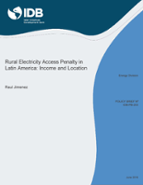Rural Electricity Access Penalty in Latin America: Income and Location
Fecha de emisión
Jun 2016
Tema
Desarrollo Rural;
Ingreso per Cápita;
Ingreso Familiar;
Servicio de Electricidad;
Pobreza;
Electrificación Rural
Código JEL
O18 - Urban, Rural, Regional, and Transportation Analysis • Housing • Infrastructure;
O2 - Development Planning and Policy;
Q40 - Energy: General
Categoría
Resúmenes de Políticas
This paper examines three intrinsic underlying variables affecting the provision of rural electricity services: household income, household location and a country's relative wealth in terms of per capita income. A cross section of nationally representative household surveys from sixteen Latin American countries provides a recent snapshot of access to electricity in the region. This examination shows that despite recent progress in rural electrification, lowincome countries still face significant challenges. Rural electricity coverage is as low as 55% for the poorest income group in some LAC countries, while around 90% of the total access gap is concentrated among the poorest households living in rural areas of low-income countries. Location explains most of the lack of access, however in low-income countries, income is also a key barrier to electrification. These patterns translate into a sizeable electricity access penalty mainly affecting poor households in poor countries, emphasizing the need for effective rural electrification programs to promote inclusive economic growth and social well being.



